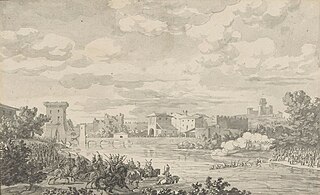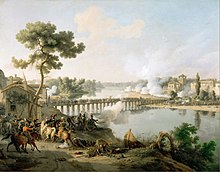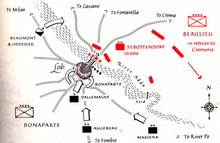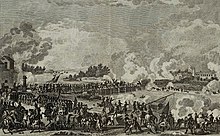
The Battle of Arcole or Battle of Arcola was fought between French and Austrian forces 25 kilometres (16 mi) southeast of Verona during the War of the First Coalition, a part of the French Revolutionary Wars. The battle saw a bold maneuver by Napoleon Bonaparte's French Army of Italy to outflank the Austrian army led by József Alvinczi and cut off its line of retreat. The French victory proved to be a highly significant event during the third Austrian attempt to lift the siege of Mantua. Alvinczi planned to execute a two-pronged offensive against Bonaparte's army. The Austrian commander ordered Paul Davidovich to advance south along the Adige River valley with one corps while Alvinczi led the main army in an advance from the east. The Austrians hoped to raise the siege of Mantua where Dagobert Sigmund von Wurmser was trapped with a large garrison. If the two Austrian columns linked up and if Wurmser's troops were released, French prospects were grim.

The Second Battle of Dego was fought on 14 and 15 April 1796 during the French Revolutionary Wars between French forces and Austro-Sardinian forces. The battle was fought near Dego, a hamlet in northwestern Italy, and ended in a French victory.

The Battle of Montenotte was fought on 12 April 1796, during the French Revolutionary Wars, between the French army under General Napoleon Bonaparte and an Austrian corps under Count Eugène-Guillaume Argenteau. The French won the battle, which was fought near the village of Cairo Montenotte in the Kingdom of Piedmont-Sardinia. The modern town is located in the northwestern part of Italy. On 11 April, Argenteau led 3,700 men in several assaults against a French mountaintop redoubt but failed to take it. By the morning of the 12th, Bonaparte concentrated large forces against Argenteau's now-outnumbered troops. The strongest French push came from the direction of the mountaintop redoubt, but a second force fell on the weak Austrian right flank and overwhelmed it. In its hasty retreat from the field, Argenteau's force lost heavily and was badly disorganized. This attack against the boundary between the Austrian and Sardinian armies threatened to sever the link between the two allies. This action was part of the Montenotte Campaign.

In the Battle of Rovereto on 4 September 1796 a French army commanded by Napoleon Bonaparte defeated an Austrian corps led by Paul Davidovich during the War of the First Coalition, part of the French Revolutionary Wars. The battle was fought near the town of Rovereto, in the upper Adige River valley in northern Italy.
Baron Paul Davidovich or Pavle Davidović became a general of the Austrian Empire and a Knight of the Military Order of Maria Theresa. He played a major role in the 1796 Italian campaign during the French Revolutionary Wars, leading corps-sized commands in the fighting against the French army led by Napoleon Bonaparte. He led troops during the Napoleonic Wars and was Proprietor (Inhaber) of an Austrian infantry regiment.

The Battle of Fombio was fought between the French Army of Italy led by Napoleon Bonaparte and the Austrian army under Feldzeugmeister Johann Peter Beaulieu between 7 and 9 May 1796. It was the decisive strategic point of the campaign, as Bonaparte crossed the Po River at Piacenza in Beaulieu's rear, threatening both Milan and the Austrian line of communications. This threat forced the Austrian army to withdraw to the east.

Johann Peter de Beaulieu, also Jean Pierre de Beaulieu, was a Walloon military officer. He joined the Habsburg army and fought against the Prussians during the Seven Years' War. A cultured man, he later battled Belgian rebels and earned promotion to general officer. During the French Revolutionary Wars he fought against the First French Republic and attained high command. In 1796, a young Napoleon Bonaparte won some of his first victories against an army led by Beaulieu. He retired and was the Proprietor (Inhaber) of an Austrian infantry regiment until his death.
In the Battle of Arcole on 15 to 17 November 1796, the French Army of Italy commanded by Napoleon Bonaparte won a victory over the army of Austria led by Jozsef Alvinczi. The battle was part of the third relief of the Siege of Mantua in which Alvinczi's army repulsed Bonaparte at the Second Battle of Bassano on 6 November and at the Battle of Caldiero on 12 November. Meanwhile, Paul Davidovich's Austrian Tyrol Corps clashed with Claude Vaubois' French division at Cembra on 2 November. Davidovich defeated Vaubois at the Battle of Calliano on 6–7 November and Rivoli Veronese on 17 November. After Bonaparte's triumph at Arcola, he turned on the Tyrol Corps, beat it at Rivoli on 21 November, and forced it to retreat north into the mountains.

In the Battle of Castiglione on 5 August 1796, the French Army of Italy under the command of General Napoleon Bonaparte defeated an Austrian army led by Field Marshal Dagobert Sigmund von Wurmser. Castiglione and the Battle of Lonato were the major actions in a campaign which marked the first attempted relief of the Siege of Mantua. While Wurmser advanced east of Lake Garda with three columns, Peter Quasdanovich moved his column into the area west of Lake Garda. The Austrians pushed back the French forces and forced Bonaparte to raise the siege. However, the French commander massed against Quasdanovich and forced him to retreat after a week of see-saw fighting. After disposing of Quasdanovich, Bonaparte turned on Wurmser and defeated the main army also. In the sequel, the French pushed the Mantua garrison back and blockaded the city.

Baron Josef Philipp Vukassovich was a Croatian soldier who joined the army of Habsburg monarchy and fought against both Ottoman Empire and the First French Republic. During the French Revolutionary Wars, he commanded a brigade in the 1796–1797 Italian campaign against Napoleon Bonaparte. He led a division during the Napoleonic Wars and received a fatal wound in action.

In the Montenotte campaign between 10 and 28 April 1796, General Napoleon Bonaparte's French Army of Italy broke the link between Feldzeugmeister Johann Peter Beaulieu's Austrian army and Feldmarschallleutnant Michelangelo Alessandro Colli-Marchi's Sardinian army. In subsequent engagements, the French defeated the Austrians, pursued Colli to the west, and forced the Sardinians to withdraw from the First Coalition against France. Actions were fought at Voltri on 10 April, Monte Negino (Legino) on 11 April, Montenotte on 12 April, Millesimo on 13 April, Second Battle of Dego on 14–15 April, Ceva on 16 April, San Michele Mondovi on 19 April, and Mondovì on 21 April.

The Montenotte campaign began on 10 April 1796 with an action at Voltri and ended with the Armistice of Cherasco on 28 April. In his first army command, Napoleon Bonaparte's French army separated the army of the Kingdom of Sardinia-Piedmont under Michelangelo Alessandro Colli-Marchi from the allied Habsburg army led by Johann Peter Beaulieu. The French defeated both Habsburg and Sardinian armies and forced Sardinia to quit the First Coalition. The campaign formed part of the Wars of the French Revolution. Montenotte Superiore is located at the junction of Strada Provinciale 12 and 41 in the Liguria region of northwest Italy, 15 kilometres (9 mi) northeast of Carcare municipality. However, the fighting occurred in an area from Genoa on the east to Cuneo on the west.

The Battle of Borghetto, near Valeggio sul Mincio in the Veneto of northern Italy, took place during the War of the First Coalition, part of the French Revolutionary Wars. On 30 May 1796, a French army led by General Napoleon Bonaparte forced a crossing of the Mincio River in the face of opposition from an Austrian army commanded by Feldzeugmeister Johann Peter Beaulieu. This action compelled the Austrian army to retreat north up the Adige valley to Trento, leaving the fortress of Mantua to be besieged by the French.

Gerhard Ritter von Rosselmini or Gherardo Rosselmini or Gerhard Roselmini became a general officer in the Austrian army during the French Revolutionary Wars and fought in several actions against Napoleon Bonaparte's French army during the 1796 Italian campaign. From 1789 to 1794 he commanded an Austrian infantry regiment. He led the unit in several battles on the upper Rhine in 1793 before being captured. He was promoted to General Major in early 1794. Rosselmini died in Italy while on campaign.
Karl Philipp Sebottendorf van der Rose enrolled in the Austrian army at the age of 18, became a general officer during the French Revolutionary Wars, and commanded a division against Napoleon Bonaparte in several notable battles during the Italian campaign of 1796.

The Battle of Verona was fought on 18 October 1805 between the French Army of Italy under the command of André Masséna and an Austrian army led by Archduke Charles, Duke of Teschen. By the end of the day, Massena seized a bridgehead on the east bank of the Adige River, driving back the defending troops under Josef Philipp Vukassovich. The action took place near the city of Verona in northern Italy during the War of the Third Coalition, part of the Napoleonic Wars.

Marc-Antoine de Beaumont a French nobleman, became a page to the king and joined the army of the Old Regime. He stayed in the army during the French Revolution and narrowly escaped being executed. During the French Revolutionary Wars he fought in the 1796 Italian campaign under Napoleon Bonaparte, leading the cavalry at Lodi and Castiglione. In 1799 he was wounded in Italy but fought there again in late 1800.
Anton Schübirz or Anton Schubirz von Chobinin was an Austrian General-major. He fought for Habsburg monarchy against Ottoman Turkey and the French First Republic. He participated in several noteworthy actions during the French Revolutionary Wars. As a newly promoted general officer in Italy, he led a brigade in an all-night action against the French at Codogno, part of the Battle of Fombio in May 1796. In the sparring before the Battle of Castiglione, he showed initiative in bringing his troops to the assistance of a fellow general. He also fought at Fontaniva, Caldiero, and Arcole in the autumn of 1796. This was the theater of war where a young French general named Napoleon Bonaparte earned his fame. Schübirz retired from the army in 1798 and died three years later.
The Battle of Voltri was an engagement occurring on 10 April 1796 during the French Revolutionary Wars and taking place in Voltri, a suburb of Genoa, Italy.
Philipp Pittoni Freiherr von Dannenfeld, fought in the army of Habsburg Austria during the French Revolutionary Wars. Promoted to general officer in 1795, he was a brigade commander in northwestern Italy at the time when Napoleon Bonaparte was appointed to lead the opposing French Army of Italy. Pittoni led one of the two main columns at Voltri in April 1796. At Borghetto in May, he unsuccessfully defended the bridge. He led a brigade at Castiglione in August and at Second Bassano and Arcole in November 1796. He retired from service the following year and died at Gorizia in 1824.



















